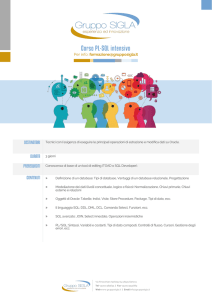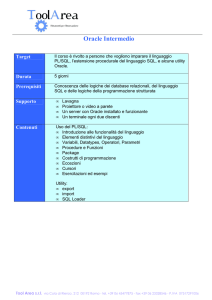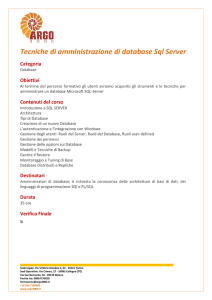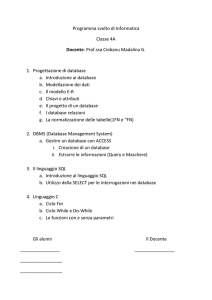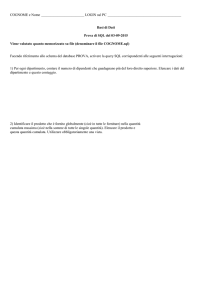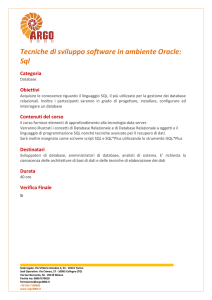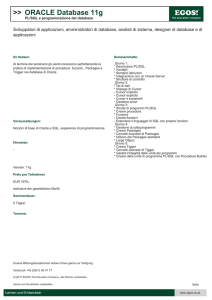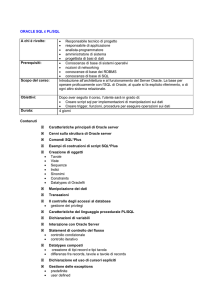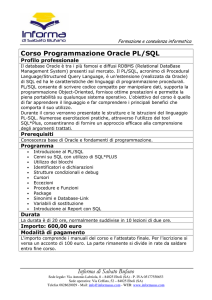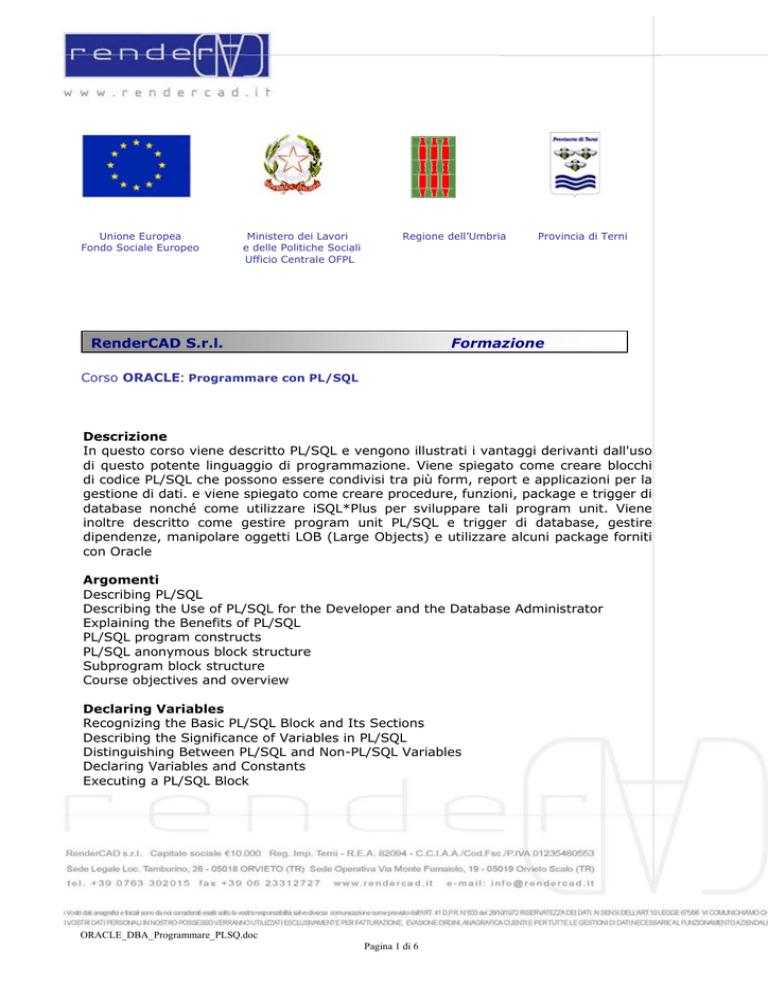
Unione Europea
Fondo Sociale Europeo
Ministero dei Lavori
e delle Politiche Sociali
Ufficio Centrale OFPL
Regione dell’Umbria
RenderCAD S.r.l.
Provincia di Terni
Formazione
Corso ORACLE: Programmare con PL/SQL
Descrizione
In questo corso viene descritto PL/SQL e vengono illustrati i vantaggi derivanti dall'uso
di questo potente linguaggio di programmazione. Viene spiegato come creare blocchi
di codice PL/SQL che possono essere condivisi tra più form, report e applicazioni per la
gestione di dati. e viene spiegato come creare procedure, funzioni, package e trigger di
database nonché come utilizzare iSQL*Plus per sviluppare tali program unit. Viene
inoltre descritto come gestire program unit PL/SQL e trigger di database, gestire
dipendenze, manipolare oggetti LOB (Large Objects) e utilizzare alcuni package forniti
con Oracle
Argomenti
Describing PL/SQL
Describing the Use of PL/SQL for the Developer and the Database Administrator
Explaining the Benefits of PL/SQL
PL/SQL program constructs
PL/SQL anonymous block structure
Subprogram block structure
Course objectives and overview
Declaring Variables
Recognizing the Basic PL/SQL Block and Its Sections
Describing the Significance of Variables in PL/SQL
Distinguishing Between PL/SQL and Non-PL/SQL Variables
Declaring Variables and Constants
Executing a PL/SQL Block
ORACLE_DBA_Programmare_PLSQ.doc
Pagina 1 di 6
Unione Europea
Fondo Sociale Europeo
Ministero dei Lavori
e delle Politiche Sociali
Ufficio Centrale OFPL
Regione dell’Umbria
RenderCAD S.r.l.
Provincia di Terni
Formazione
Corso ORACLE: Programmare con PL/SQL
Writing Executable Statements
Recognizing the Significance of the Executable Section
Writing Statements Within the Executable Section
Describing the Rules of Nested Blocks
Executing and Testing a PL/SQL Block
Using Coding Conventions
Interacting with the Oracle Server
Writing a Successful SELECT Statement in PL/SQL
Declaring the Data type and Size of a PL/SQL Variable Dynamically
Writing Data Manipulation Language (DML) Statements in PL/SQL
Controlling Transactions in PL/SQL
Determining the Outcome of SQL DML Statements
Writing Control Structures
Identifying the Uses and Types of Control Structures
Constructing an IF Statement
Constructing and Identifying Different Loop Statements
Controlling Block Flow Using Nested Loops and Labels
Using Logic Tables
Working with Composite Data types
Creating User-Defined PL/SQL Records
Creating a PL/SQL Table
Creating a PL/SQL Table of Records
Differentiating Among Records, Tables, and Tables of Records
ORACLE_DBA_Programmare_PLSQ.doc
Pagina 2 di 6
Unione Europea
Fondo Sociale Europeo
Ministero dei Lavori
e delle Politiche Sociali
Ufficio Centrale OFPL
Regione dell’Umbria
RenderCAD S.r.l.
Provincia di Terni
Formazione
Corso ORACLE: Programmare con PL/SQL
Writing Explicit Cursors
Using a PL/SQL Record Variable
Distinguishing Between the Implicit and Explicit Cursor
Writing a Cursor FOR Loop
Advanced Explicit Cursor Concepts
Writing a Cursor that Uses Parameters
Determining When a FOR UPDATE Clause in a Cursor Is Required
Using a PL/SQL Table Variable
Using a PL/SQL Table of Records
Handling Exceptions
Defining PL/SQL Exceptions
Recognizing Unhandled Exceptions
Listing and Using Different Types of PL/SQL Exception Handlers
Trapping Unanticipated Errors
Describing the Effect of Exception Propagation in Nested Blocks
Customizing PL/SQL Exception Messages
Creating Procedures
Describe the uses of procedures
Create procedures
Create procedures with arguments
Invoke a procedure
Remove a procedure
Creating Functions
Describe the uses of functions
Create a function
Invoke a function
Remove a function
Differentiate between a procedure and a function
ORACLE_DBA_Programmare_PLSQ.doc
Pagina 3 di 6
Unione Europea
Fondo Sociale Europeo
Ministero dei Lavori
e delle Politiche Sociali
Ufficio Centrale OFPL
Regione dell’Umbria
RenderCAD S.r.l.
Provincia di Terni
Formazione
Corso ORACLE: Programmare con PL/SQL
Managing Subprograms
Describe system privilege requirements
Describe object privilege requirements
Query the relevant data dictionary views
Debug subprograms
Creating Packages
Describe packages and list their possible components
Create packages that include public and private subprograms, as well as global and
local variables
Invoke objects in a package
Remove packages
More Package Concepts
Write packages that use the overloading feature of PL/SQL
Avoid errors with mutually referential subprograms
Initialize variables with a one-time-only procedure
Specify the purity level of packaged functions
Describe the persistent state of packaged variables, cursors, tables, and records
Query the relevant data dictionary views
Using Oracle-Supplied Packages
Overview of Oracle-supplied packages
View examples of some supplied packages
Write dynamic SQL
Creating Database Triggers
Describe different types of triggers
Describe database triggers and their use
Create database triggers
Describe database trigger firing rules
Drop database triggers
ORACLE_DBA_Programmare_PLSQ.doc
Pagina 4 di 6
Unione Europea
Fondo Sociale Europeo
Ministero dei Lavori
e delle Politiche Sociali
Ufficio Centrale OFPL
Regione dell’Umbria
RenderCAD S.r.l.
Provincia di Terni
Formazione
Corso ORACLE: Programmare con PL/SQL
More Trigger Concepts
Create triggers that fire when certain database actions occur
List some of the limitations of database triggers
Determine when to use database triggers or Oracle Server features
Create triggers by using alternative events (notINSERT/UPDATE/DELETE)
Create triggers by using alternative levels (not STATEMENT/ROW)
Query the relevant data dictionary views
Managing Dependencies
Overview of object dependencies
Manage PL/SQL objects for recompilation
Manipulating Large Objects
Compare and contrast LONG/RAW/LONG RAW with large objects (LOBs)
Understand LOBs
Manage binary large file objects (BFILEs)
Use PL/SQL with an LOB
Create a table with LOB columns
Manipulate LOBs
Use DBMS_LOB Oracle-supplied packages
Create a temporary LOB
Obiettivi
descrivere i package forniti con Oracle;
descrivere le funzioni e la sintassi di PL/SQL;
gestire errori in fase di esecuzione;
creare, eseguire e gestire procedure, funzioni, package e trigger;
eseguire il controllo condizionale del flusso di codice (loop, strutture di controllo e
cursori espliciti);
gestire costrutti di programma;
gestire dipendenze.
manipolare oggetti LOB (Large Objects);
ORACLE_DBA_Programmare_PLSQ.doc
Pagina 5 di 6
Unione Europea
Fondo Sociale Europeo
Ministero dei Lavori
e delle Politiche Sociali
Ufficio Centrale OFPL
Regione dell’Umbria
RenderCAD S.r.l.
Provincia di Terni
Formazione
Corso ORACLE: Programmare con PL/SQL
Partecipanti
Analisti di sistema
Amministratori di database
Personale Tecnico di supporto
Prerequisiti consigliati
Introduction to Oracle: SQL
Docenti
Personale docente Oracle University.
Durata del corso: 30 ore, in 5 giorni.
ORACLE_DBA_Programmare_PLSQ.doc
Pagina 6 di 6


